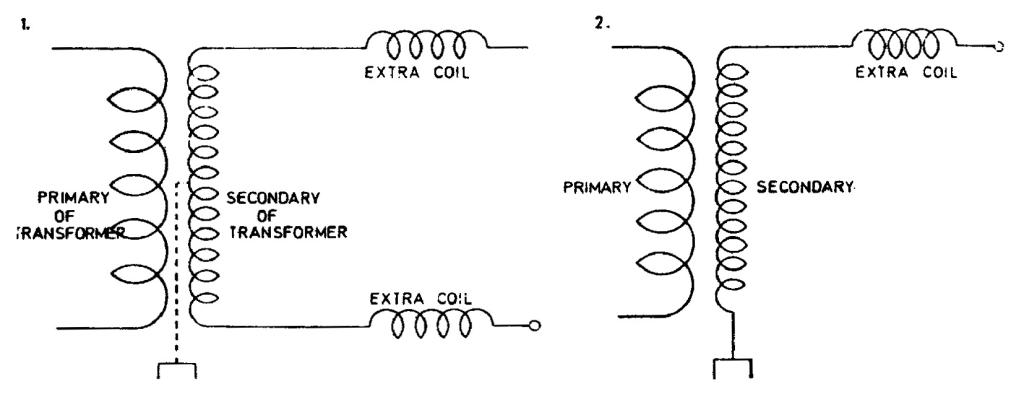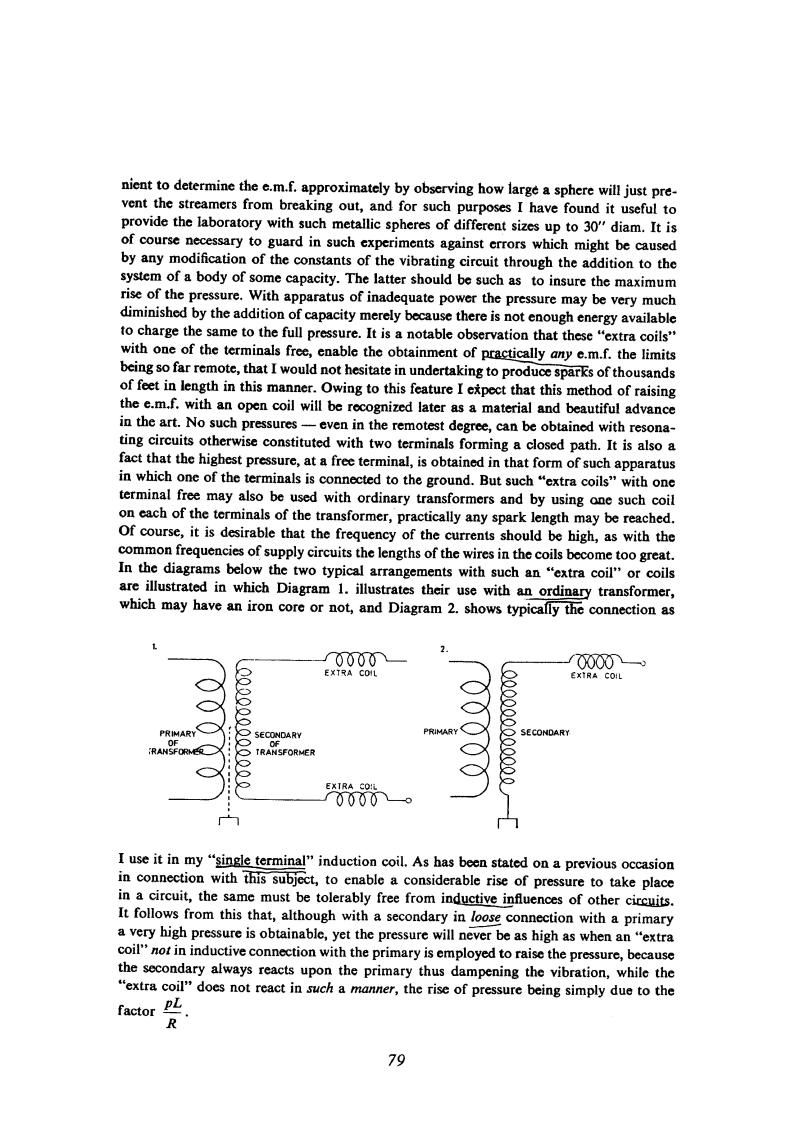
Nikola Tesla Books
nient to determine the e.m.f. approximately by observing how large a sphere will just prevent the streamers from breaking out, and for such purposes I have found it useful to provide the laboratory with such metallic spheres of different sizes up to 30" diam. It is of course necessary to guard in such experiments against errors which might be caused by any modification of the constants of the vibrating circuit through the addition to the system of a body of some capacity. The latter should be such as to insure the maximum rise of the pressure. With apparatus of inadequate power the pressure may be very much diminished by the addition of capacity merely because there is not enough energy available to charge the same to the full pressure. It is a notable observation that these âextra coilsâ with one of the terminals free, enable the obtainment of practically any e.m.f. the limits being so far remote, that I would not hesitate in undertaking to produce sparks of thousands of feet in length in this manner. Owing to this feature I expect that this method of raising the e.m.f. with an open coil will be recognized later as a material and beautiful advance in the art. No such pressures - even in the remotest degree, can be obtained with resonating circuits otherwise constituted with two terminals forming a closed path. It is also a fact that the highest pressure, at a free terminal, is obtained in that form of such apparatus in which one of the terminals is connected to the ground. But such âextra coilsâ with one terminal free may also be used with ordinary transformers and by using one such coil on each of the terminals of the transformer, practically any spark length may be reached. Of course, it is desirable that the frequency of the currents should be high, as with the common frequencies of supply circuits the lengths of the wires in the coils become too great. In the diagrams below the two typical arrangements with such an âextra coilâ or coils are illustrated in which Diagram 1. illustrates their use with an ordinary transformer, which may have an iron core or not, and Diagram 2. shows typically the connection as
I use it in my âsingle terminalâ induction coil. As has been stated on a previous occasion in connection with this subject, to enable a considerable rise of pressure to take place in a circuit, the same must be tolerably free from inductive influences of other circuits. It follows from this that, although with a secondary in loose connection with a primary a very high pressure is obtainable, yet the pressure will never be as high as when an âextra coilâ not in inductive connection with the primary is employed to raise the pressure, because the secondary always reacts upon the primary thus dampening the vibration, while the âextra coilâ does not react in such a manner, the rise of pressure being simply due to the factor $! {pL \over R} $!.
79
July 11
By introducing the additional coil in the oscillator circuit Tesla achieved one modification of his oscillator with resonant transformer. by which means he obtained higher voltages. When these voltages exceeded several hundred thousand volts, he had to carefully lay out the elements, and choose very good insulators. Here the instructions are given how to make the terminals in order to obtain longest and most powerful spark along with delaying the flashover to the instant when maximum voltage is reached (or some desired voltage). He suggests the procedure which enables the voltage measurement by means of metal spheres of various radii. He discusses the disadvantages of this method because the spheres introduce additional capacitance which disturbs the resonance conditions in high frequency circuits.
Tesla considers the additional coil extraordinarily suitable for the achievement of "any" voltage. He gives two wiring schematics of this coil for an oscillator high frequency transformer. He claims that with this coil. considerably higher voltages are achieved than with the secondary in poorer linkage with the primary.
Tesla explains this with the fact that the additional coil is not in an inductive link with the primary, and there is no such reaction in the primary which would dampen the oscillation. He doesn't explain how he imagines this coil to be excited and not to react on the primary transformer secondary to which it is directly connected.
The additional coil description is very detailed. Tesla's wealthy experience in coil design is obvious in its full extent. At the end of his considerations he gives the equation for determination of the number of turns for the additional coil on the basis of operation frequency, wire diameter, separation of windings, and a constant which he determines on the basis of experimental results. He checks the equation on one example and obtains a result very close to the experimental results.


